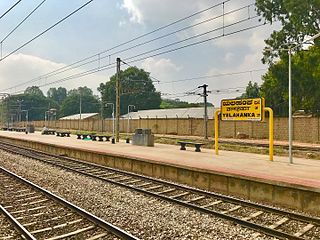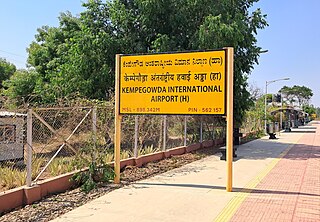
Namma Metro, also known as Bengaluru Metro, is a rapid transit system serving the city of Bengaluru, the capital city of the state of Karnataka, India. It is the second-longest operational metro network in India with an operational length of 76.95 kilometers, just behind Delhi Metro. Upon its inauguration in 2011, it became the first underground metro system in South India. Namma Metro has a mix of underground, at grade, and elevated stations. Out of the 68 operational metro stations of Namma Metro as of November 2024, there are 59 elevated stations, eight underground stations and one at-grade station. The system runs on standard-gauge tracks.

Yelahanka is a premium locality in north Bangalore and also a Taluk of Bangalore Urban district in the Indian state of Karnataka. One of the zones of BBMP. It is the oldest part of present Municipal Bengaluru (Bangalore) city and the northern end of the city. It is Nadaprabhu Kempegowda I, of the Yelahanka Prabhu clans, who laid the foundation of present-day Bengaluru through the creation of a "mud fort town" in 1537 CE

Tumkur, officially Tumakuru, is a city and headquarters of Tumakuru district in the Karnataka state of India. Tumkur is known for Siddaganga Matha. Tumkur hosts India's first mega food park, a project of the ministry of food processing. The India Food Park was inaugurated by Prime Minister of India in September 2014. Tumkur is also included in the Smart Cities Mission list and is among the 100 smart cities to be developed in India. Since 28 August 2010, Tumkur has been accorded the status of a city corporation.

Ahmedabad Metro is a rapid transit system for the cities of Ahmedabad and Gandhinagar in Gujarat state of India. Currently the network is 58.66 km (36.450 mi) long and has 39 stations.

Urban rail transit in India plays an important role in intracity transportation in the major cities which are highly populated. It consists of Regional Rapid Transit System, suburban rail, monorail, and tram systems.

Green Line of Namma Metro was built along with the Purple Line during the first phase of construction of the metro rail system for the city of Bengaluru, Karnataka, India. The 30.5 km (19.0 mi) line connects Madavara in the northwest to Silk Institute in the south. The line connects the industrial centers of Peenya and Yeshwanthpur along Tumakuru Road in the north with the central hub of Majestic and the southern residential areas of Bangalore such as Basavanagudi, Jayanagar, Banashankari, Konanakunte Cross, Thalaghattapura along Kanakapura Road. Green Line is mostly elevated, with 26 elevated and 3 underground stations. The Line passes through Majestic station which is an interchange station between Green and Purple Lines.

The Purple Line is a part of the Namma Metro rail system for the city of Bengaluru, Karnataka, India. As of 2023, the line is 43.49 km (27.02 mi) long and spans 37 stations from Challaghatta in the southwest to Whitefield (Kadugodi) to the east. The Purple Line is mostly elevated, with 31 elevated stations, 5 underground stations and 1 at-grade station. The Line passes through many prime activity centers of the city including Whitefield, Krishnarajapura, MG Road, Vidhana Soudha and Majestic station, which is an interchange station between Purple and Green Lines. Phase I of the Purple Line was the first underground metro section in South India.
Yelahanka Lake is a water body near Yelahanka, a suburb of Bangalore.
Coimbatore Metro, also known as Kovai Metro, is a proposed rapid transit system for Coimbatore, Tamil Nadu.
The Pink Line of Namma Metro is under construction and will form part of the metro rail network for the city of Bangalore, Karnataka, India. The 21.25 km (13.20 mi) line connects Kalena Agrahara station on Bannerghatta Road in the south with Nagawara station on Outer Ring Road in the north. The Pink Line is mostly underground but also has a 6.98 km (4.34 mi) elevated section and a 0.48 km (0.30 mi) at-grade (surface) section. There are 18 stations on the line, including 12 underground and 6 elevated ones. Pink Line will have an interchange with the Purple Line at MG Road station. It will also have interchanges with the Yellow line at Jayadeva Hospital station and with the Blue Line at Nagawara. Both these lines are under construction.

Whitefield railway station is an Indian Railways train station located in Whitefield, Bangalore, in the Indian state of Karnataka, which is about 8 km away from the Krishnarajapuram railway station and serves the Whitefield area.

Yelahanka Junction railway station is an Indian Railways station in the outskirts of Bangalore in the Indian state of Karnataka, located in Yelahanka locality about 25 km away from the Bangalore City. This station is located on the Guntakal–Bangalore line.
Transport in Bengaluru consists of several intracity commute modes such as BMTC buses, Namma Metro rail services, taxis and auto rickshaws, as well as several intercity forms of transport: Government operated KSRTC, NWKRTC, KKRTC, other states RTC buses, Private bus operators, trains, and flights.
Kerala Rail Development Corporation d/b/a Kerala-Rail is a public sector joint venture company under the ownership of the Government of Kerala for the railway infrastructure development in Kerala. The company was incorporated on 3 January 2017.

Kempegowda International Airport Halt railway station is an Indian Railways railway station located near Kempegowda International Airport, Bangalore in the Indian state of Karnataka, about 45 km away from the Bangalore City on the Yelahanka–Kolar line. This station will serve the Kempegowda International Airport.
The Blue Line or ORR-Airport Metro Line is part of the Namma Metro rail network for the city of Bangalore, Karnataka, India. It consists of two sections - Phase-2A and Phase-2B. Construction of Phase-2A began in August 2021. Construction of Phase-2B began in February 2022. The 58.19 km line connects Central Silk Board with the Kempegowda International Airport. The Line is mostly elevated but also has an at-grade (surface) section close to the Airport and 2 short underground sections where it passes the Jakkur Aerodrome and Yelahanka AFB. There are 30 stations on the line of which the two station/s at the Airport may be at surface level or underground. Blue Line will have interchanges with the Yellow Line at Central Silk Board, Purple Line at KR Pura, Pink Line at Nagawara and with the future /proposed Orange Line at Hebbal.

Yelahanka is an upcoming important elevated metro station on the North-South corridor of the Blue Line of Namma Metro in Bangalore, India. This metro station will serve the main Yelahanka suburban area, which contains Yelahanka Junction, along with its Rail Wheel Factory, Yelahanka Lake and Yelahanka Air Force Station. It also includes many residential areas such as SOBHA Palm Court Apartments, Park View Apartments and SLV Nest Apartments.

Bagalur Cross is an upcoming elevated metro station on the North-South corridor of the Blue Line of Namma Metro in Bangalore, India. This metro station will consist of the main Bagalur area with many educational institutions like Chrysalis High (Yelahanka), Ryan International School, Nitte Meenakshi Institute of Technology followed by prime locations like Zodiac Clothing Company Ltd., Palanahalli Lake Park, Manipal Academy of Higher Education and BSF Institute of Technology. This metro station is slated to be operational around June 2026.
Airport City is an upcoming at-grade metro station on the north-south corridor of the Blue Line of Namma Metro in Bangalore, India. This will be an important metro station that will comprise many commercial infrastructures that will be developed by BIAL, including the KIA Air Traffic Control Tower, Nadaprabhu Kempegowda Statue, a few catering manufacturing companies including SATS, Air India's SATS, Blue Dart Express, and IndiGo Hangar for maintenance and training purposes. This metro station is to become operational around June 2026.
The Chennai-Mysuru high speed rail corridor is India's third high-speed rail project after the Mumbai Ahmedabad High Speed Rail Corridor and Delhi Varanasi High Speed Rail Corridor. The 435 km HSR corridor will connect Chennai to Mysuru through 9 stations.
















